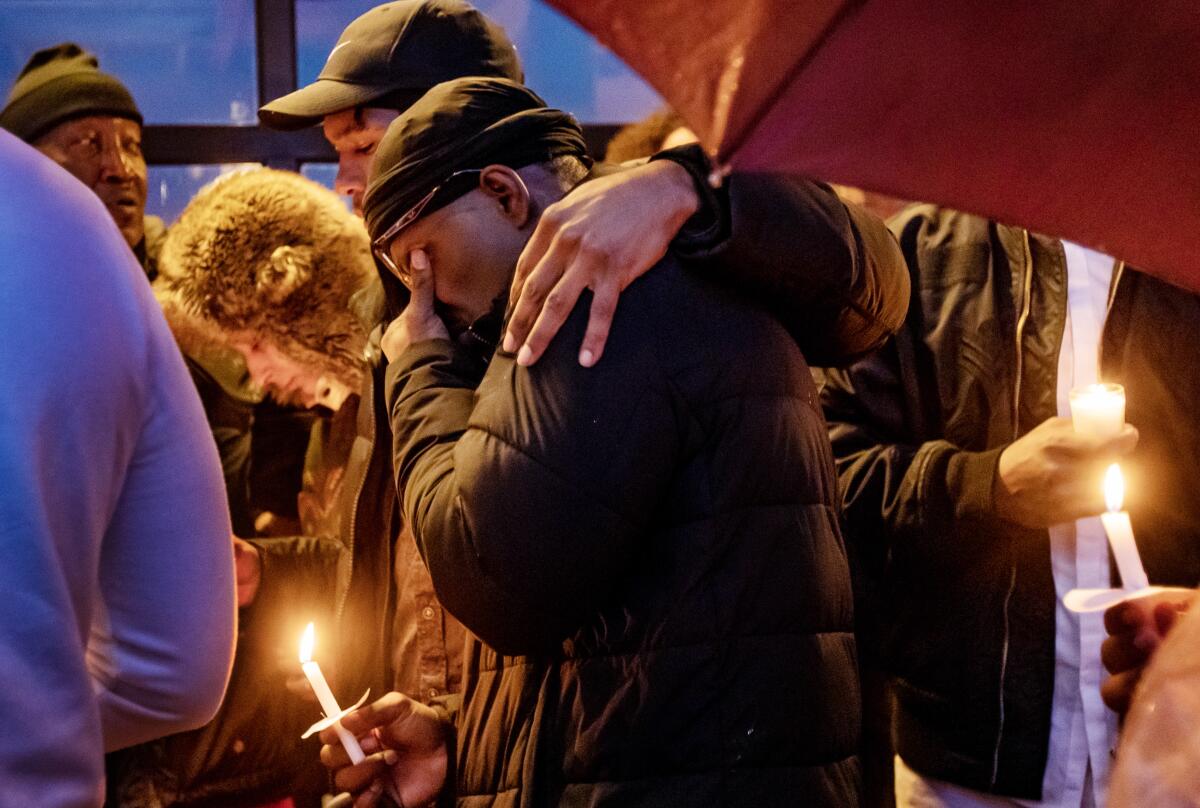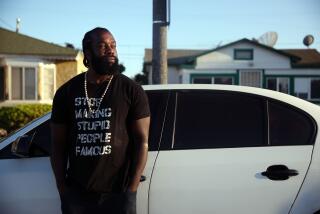Family of Keenan Anderson files wrongful death suit against LAPD

- Share via
The family of Keenan Anderson has filed a wrongful-death lawsuit against the city of Los Angeles, alleging that police officers used excessive force when they piled on top of the 31-year-old teacher at a busy Venice intersection and Tasered him after a minor traffic collision this year.
Anderson’s relatives on Monday also reiterated their demand that the department identify the officers involved in the Jan. 3 incident, which drew widespread condemnations and reignited a debate over the role of police in traffic enforcement.
Carl Douglas, the attorney who filed the suit Friday on behalf of Anderson’s family, said an autopsy finding of cocaine in the 31-year-old’s bloodstream shouldn’t have necessitated the use of “excessive and unreasonable force” by officers. Anderson was in clear distress, and what he needed in that moment was medical care, not police intervention, he said.
“I care not what the coroner’s office says about him having cocaine in his system at the time of his death. We did an autopsy ourselves, and the results were the same,” Douglas told reporters at a news conference Monday morning. “But it matters not whether there was cocaine in his system, as the actions of the officers were wrong. It matters not why he was in distress, because it was clear from the body-worn footage that he was never a threat.”
Douglas said he chose to announce the lawsuit on Juneteenth because of the frequency with which young Black men are subjected to police abuse across the country. He said the family’s attorneys have yet to see the full, unedited body-camera videos of the encounter.
The LAPD previously released two abridged videos showing officers the moments when Anderson was Tasered while struggling with a group of police officers. He died at a hospital a few hours later.
“Seeing that videotape says everything I need to know to tell me that his death was wrongful,” said Douglas, who is representing Anderson’s 5-year-old son along with another prominent civil rights attorney, Benjamin Crump. “We are filing a $100-million lawsuit against the law enforcement officials who caused this wrongful death.”
An LAPD spokesperson said the department had no further comment on the case and generally doesn’t speak about pending litigation.
Capt. Kelly Muniz, the department spokesperson, said the LAPD no longer names officers in in-custody deaths — only those involved in on-duty shootings — a policy that was revised in the last few years.
LAPD Chief Michel Moore and Mayor Karen Bass previously both pledged a thorough investigation into Anderson’s death. Speaking before the department’s oversight board June 6, Moore said that he expected the department’s probe of the incident to be finished in mid-July and that he would make a ruling on the case by the following month.
He previously said the incident had caused the department to review its policy on Taser use. It has also been in talks with the stun gun’s manufacturer about possibly acquiring a newer version of the device that’s still in prototype form, Moore told the Police Commission.
The encounter that ended with Anderson’s death began sometime before 3:30 p.m. on Jan. 3, when a motorcycle officer responded to what the LAPD characterized as a “felony hit-and-run” car crash at Venice and Lincoln boulevards. The still-unnamed officer encountered Anderson darting on foot through traffic in apparent distress.
In videos released by the LAPD, Anderson became distraught and cried out for help as multiple officers held him down using their body weight and arm holds. The footage also captured Anderson screaming out in pain as one officer shocked him at least six times in 42 seconds, according to details released by authorities. Eventually, he was handcuffed and hobbled at his ankles before paramedics took him away.
Several policing experts who reviewed video of the incident for The Times previously said that the amount of force used by the police seemed excessive given Anderson’s actions and that the officers’ tactics appeared haphazard.
Anderson, a father of one, had been in town from the East Coast visiting relatives when the incident occurred.
His death drew international attention in part because Anderson is a cousin of Patrisse Cullors, a co-founder of the Black Lives Matter Global Network and longtime advocate against police violence.
A few weeks after the incident, the family filed a $50-million wrongful-death claim against the city, a necessary precursor to its lawsuit.
The case returned to the headlines this month after the L.A. County coroner released its autopsy report identifying an enlarged heart and cocaine use as the causes of death. But the coroner’s office made no ruling on whether it considered Anderson’s death a homicide, saying his manner of death was undetermined. Several people have died under similar circumstances in recent years.
Anderson’s relatives pushed back on the autopsy findings. In a follow-up interview with The Times, Douglas said he was baffled by the inconclusiveness of the coroner’s report.
“For the L.A. coroner to have a press conference basically to besmirch a dead man’s reputation is regrettable and rare and it tells me they’re already circling the wagons, and that’s regrettable. Two, that doesn’t matter, what matters is the way they treated him and why,” Douglas said. “This is what they do, they attack the reputation of the person who has died. When the guy has a gun, they freeze-frame the handgun in the video.”
He reiterated that the officers’ response was overboard, considering that Anderson posed no threat to anyone other than himself.
“This guy was submissive. He was calling people, ‘Sir,’ as they were killing him.”
Activists and some City Council members say Anderson’s death lent even greater urgency to efforts to remove armed police officers from certain traffic duties, arguing that communities of color have historically borne the brunt of such enforcement. The argument is a central tenet of a nationwide movement to radically transform the criminal justice system that took hold after the murder of George Floyd in Minneapolis police custody three years ago.
A long-delayed study from an outside firm, set to be released this year, is expected to call for civilian workers to respond to minor traffic calls, in tandem with major infrastructure upgrades that improve safety along city streets that are among the nation’s deadliest.
The debate over the role of law enforcement in traffic incidents stretches back decades but intensified in the wake of Floyd’s murder and the ensuing nationwide reckoning in which critics challenged some long-held assumptions around policing.
In late 2019, the LAPD drastically scaled back on pretextual stops — pulling over random vehicles for a minor traffic violation to look for more serious crimes — after a Times investigation found that the department stopped and searched Black and Latino drivers at higher rates than whites.
More to Read
Sign up for Essential California
The most important California stories and recommendations in your inbox every morning.
You may occasionally receive promotional content from the Los Angeles Times.












